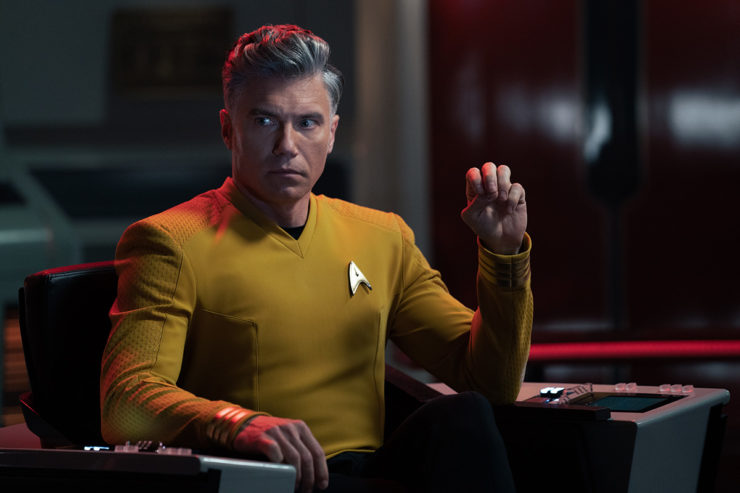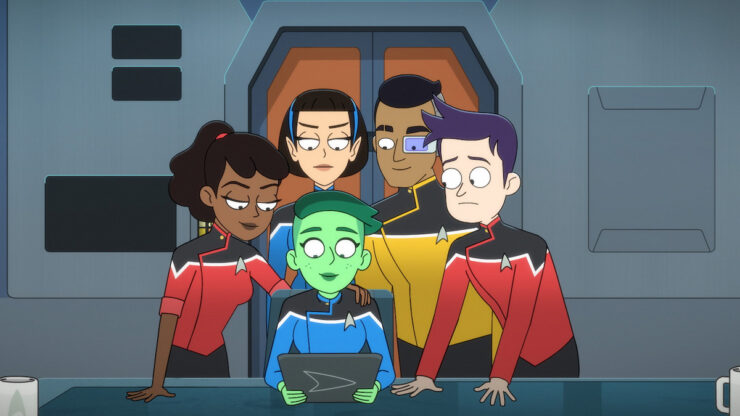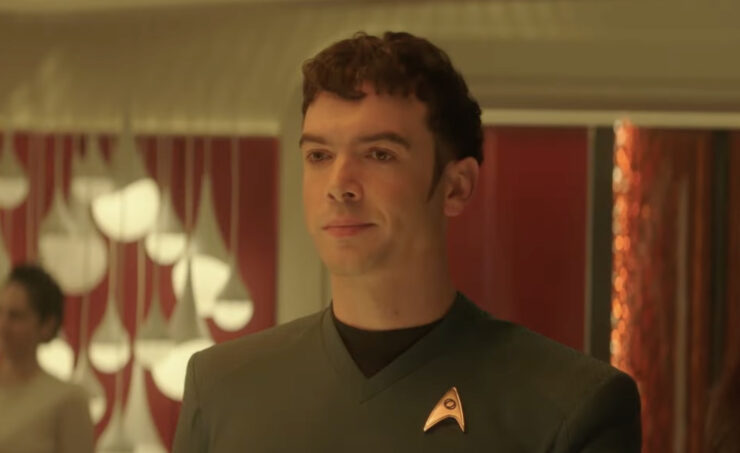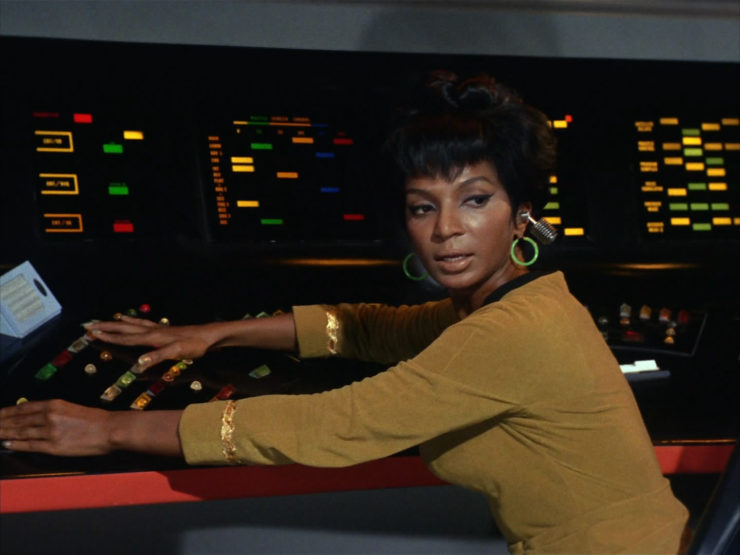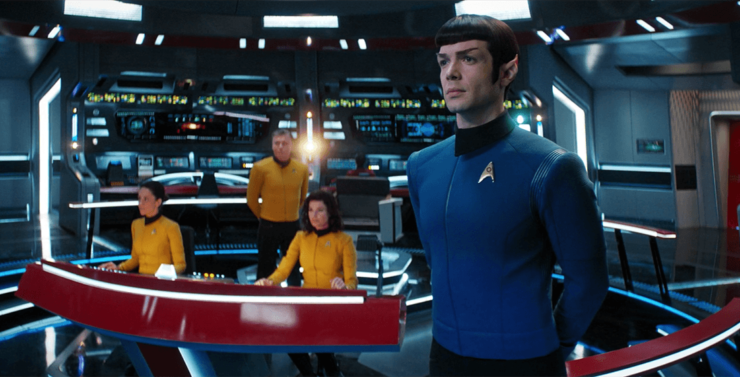I’ve said this before, but it bears repeating: there was, I’m fairly certain, absolutely nobody clamoring for a Captain Pike TV show prior to 2019.
Then the Discovery second-season premiere “Brother” aired with Anson Mount being amazing as Pike, and then Rebecca Romijn showed up as a fabulous Number One in “An Obol for Charon,” and then, after several Spock-teases, Ethan Peck fully arrived as a conscious person and was brilliant as one of the most popular characters in science fiction television in “Light and Shadows,” and at that point, the notion of a Captain Pike TV show was something that a lot of fans were desiring greatly.
After a season of Strange New Worlds, overall, the Captain Pike series has been a success.
A complete success it isn’t, mind you. There are some issues with the first series of SNW, but overall, this is more or less exactly what we were hoping for as Discovery’s second season progressed three years ago, and I’m insanely happy with the ten-episode season I just watched.
It begins at the top, with Mount, who continues to be amazing. Mount’s facility with facial expressions—where you can see every emotion played out on his pores—perfectly suits his Captain Daddy approach to running the Enterprise. He views everyone on his ship as family, cooking for them, wanting to get to know them personally, and understanding them. Plus, he’s still, at heart, a true Starfleet captain: always searching for the compassionate response, and making use of all the resources around him to get the job done. That last was probably best seen in “Memento Mori” when Pike is playing a game of chess in a nebula with the Gorn and making use of everyone’s suggestions.
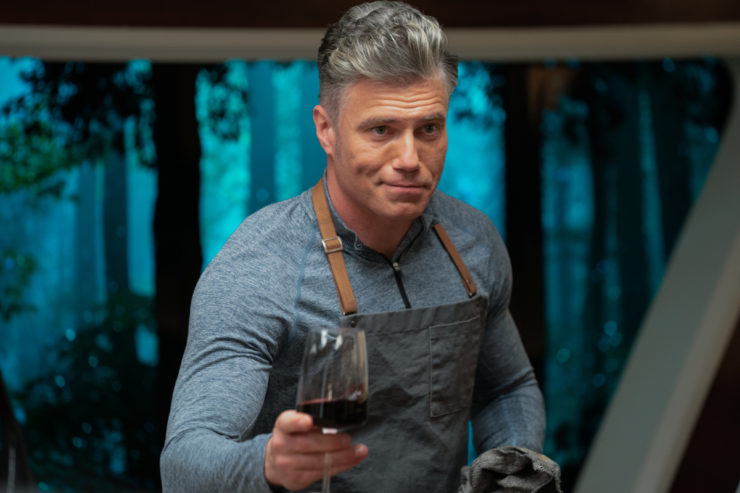
The season also spent a great deal of time on one aspect of Pike’s character that carries over from the events of Discovery season two, specifically Pike’s learning of his eventual fate (as chronicled in the episode of the original series that introduced Pike to audiences, “The Menagerie”) in “Through the Valley of Shadows.” Knowing that he is fated to be brutally injured saving the lives of a bunch of cadets is something that haunts Pike throughout the season. I was disappointed that they were harping on this, but it looks like Pike’s attempt to alter his fate—something he was explicitly told was impossible when he got the vision, something he did, by the way, in order to save all life in the galaxy—in “A Quality of Mercy” will have cured him of trying to change the future that we already know he can’t change anyhow.
(A friend on Facebook asked the question of why the people who gave him the vision of the future couldn’t say, “Hey, it’s okay, it turns out all right in the end,” since the vision in question didn’t show him the aftermath when Spock kidnaps him and takes him to Talos IV. I reminded that friend that these were Klingons—they wouldn’t view an illusory life of leisure on a planet full of telepaths to be a happier ending…)
Peck gets plenty of time in the spotlight as a younger Spock, and it’s a joy to behold. The producers decided to develop the relationship between Spock and T’Pring, going against the assumption (which was implied but never stated outright) that the pair of them hadn’t seen each other since their betrothal at age seven. Having them actually try to develop a relationship eight years prior to “Amok Time” is a fascinating (sorry…) choice, and Gia Sandhu’s portrayal of T’Pring is particularly superlative. It’s fun seeing how they’re building toward the adversarial relationship we see in the original series episode.
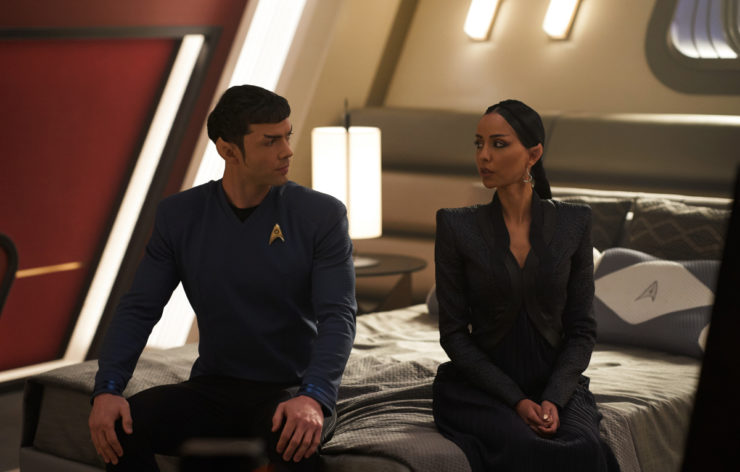
On top of that, after complaints from many about the lack of any mention of Sybok—established in The Final Frontier as Sarek’s son from a previous marriage—in the backstory of Spock and Michael Burnham that we got throughout the first two seasons of Discovery, we finally get a glimpse of Spock’s emotional half-brother at the end of “The Serene Squall,” with the promise of more next year. That episode also gave us a scenery-chewing performance by Jesse James Keitel as a pirate captain who is gleefully set up as a recurring adversary for our heroes.
In addition, by having Christine Chapel—played with verve and sass by Jess Bush—serving as a civilian advisor it actually gives a lot more texture and depth to the Spock-Chapel sexual tension seen in the original series. I’ve actually found that, upon rewatching episodes that showed the Spock-Chapel relationship in the original series (particularly “The Naked Time,” “Amok Time,” “Plato’s Stepchildren,” and “Return to Tomorrow”) that showing that their friendship goes back many years gives all those episodes more weight. It particularly makes Chapel’s mooning over Spock less oogy. (Even SNW season one can’t save the animated episode “Mudd’s Passion,” however…)
They also remembered that Chapel’s background is in bio-research, as established in the original series’ “What Are Little Girls Made Of?” and we’ve got her working on ways of disguising humans as aliens, building on the work done by Phlox in Enterprise and which is more commonplace in the later shows.
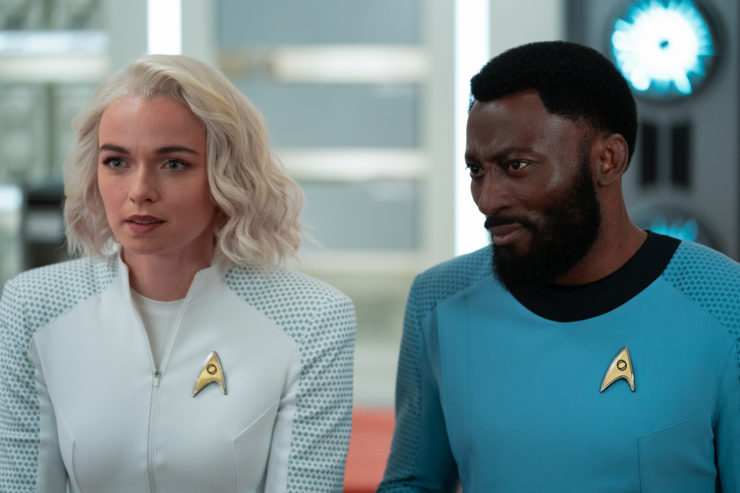
Chapel works with M’Benga, played by Booker Bradshaw in two episodes of the original series, and who is a hard-working physician here as played by Babs Olusanmokun, one who is also trying to save the life of his daughter, a cure (of sorts) that he finally finds in “The Elysian Kingdom.”
That episode shows that SNW is embracing some of the loonier aspects of Trek, too. Where most of the other Secret Hideout shows (Discovery, Picard, Prodigy) are embracing serialized storytelling, SNW is following the lead of Lower Decks to do each episode as its own thing, while still advancing character arcs. Each episode tells a complete story, and that’s a nice change from the other shows—it’s not better, it’s not worse, it’s just different, which is a good thing. One of Star Trek’s (many) strengths is that it can support multiple formats, and this show is a nice reminder of that. In this season alone, we’ve got a strong first-contact story (“Strange New Worlds”), a tense space-battle (“Memento Mori”), a nifty exploration of an alien computer to the annoyance of its acolytes (“Children of the Comet”), a space-virus tale (“Ghosts of Illyria”), a romantic comedy with a sci-fi twist (“Spock Amok”), the silly everyone-dresses-up-and-is-someone-different episode (“The Elysian Kingdom”), a space pirate episode (“The Serene Squall”), the captain-sleeps-with-a-space-babe episode (“Lift Us Where Suffering Cannot Reach”), and the people-trapped-in-a-place-with-a-scary-monster episode (“All Those Who Wander”).
Celia Rose Gooding is also superb as a younger Nyota Uhura, taking a character who was always more important for what she represented than for what little character development she ever got, and giving her more depth. We learned more about Uhura in the opening scenes of “Children of the Comet” than we’d learned in the prior eight-five TV episodes and nine movies the character appeared in. More than Bush and Olusanmokun, I have no trouble seeing Gooding’s Uhura grow into the one played by Nichelle Nichols.
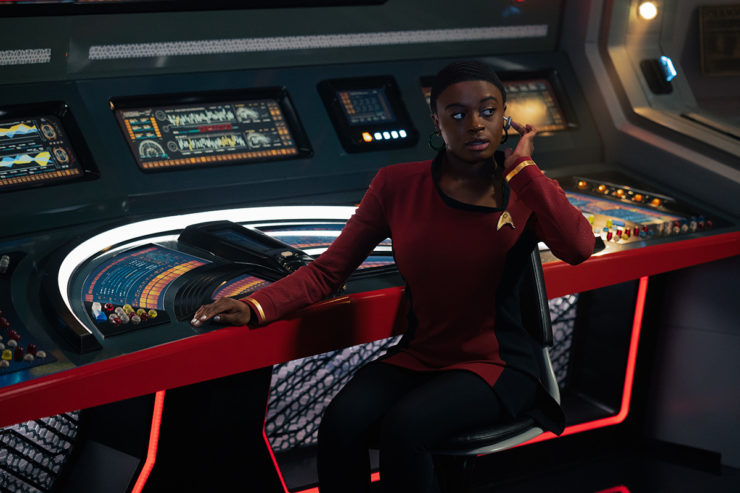
Some of the continuity hits are a bit overdone. There’s really no need to have Jim Kirk’s older brother on the ship, and he doesn’t really play a significant role beyond trolling the audience with the “Lieutenant Kirk” references in “Strange New Worlds,” and actor Dan Jeannotte looking way too much like Guy Fleegman. For that matter, there’s no real reason for M’Benga to be the ship’s doctor, and it could just as easily have been a new character. (Chapel and Uhura at least are back-filling their characters’ existing stuff.)
The only wholly new characters are, at least, interesting. Bruce Horak’s Hemmer didn’t really get much chance to shine as the only wholly alien person in the cast before being annoyingly killed in “All Those Who Wander,” the rancid cherry on top of the episode that was truly the season’s low point. Melissa Navia’s Erica Ortegas is fun, though we don’t know much about her yet, and Christine Chong’s La’An is very much what they wanted Tasha Yar to be (or perhaps Yar’s first draft, Macha Hernandez), but getting it much more right this time.
Having said that, that’s another unnecessary continuity hit, as La’An really doesn’t need to be a descendant of Khan Noonien Singh, and that bit of ancestry is by far the least interesting thing about her—her PTSD from her childhood experiences with the Gorn is way more compelling.
Also the Gorn here are completely (and unnecessarily) incompatible with the Gorn we saw in the original series’ “Arena.”
Even with all those flaws, they’re ultimately minor nits. The complaints that they’re “breaking canon” that have been howled in some circles are the same complaints we heard in 1979 when The Motion Picture came out, in 1987 when The Next Generation came out, in 2001 when Enterprise came out, and in 2017 when Discovery came out.
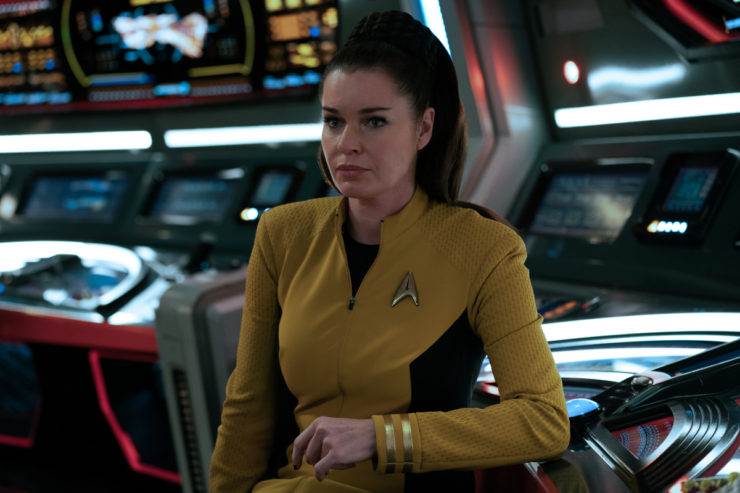
However, there is one flaw that is not a minor nit, and it’s something I’ve been complaining about pretty much all season, and I would be remiss if I didn’t mention it here.
In 2020, when this show was announced, I wrote an article here on Tor.com listing my seven thoughts on the announcement, and #6 on the list was that this should be Number One’s show. Of the “big three,” she’s the only one who’s a blank slate, as we know what happens to Pike and (especially) Spock. She has the most room for growth and development.
Buy the Book


The City Inside
On top of that, she’s a great character, a no-nonsense, super-competent officer who was shown, both in “The Cage” and in her appearances on Discovery and Short Treks to be the person Pike relies on to get shit done.
On SNW, though, she’s been marginalized, set aside, made into a virtual criminal, and/or ignored. She started the season as a damsel in distress for Pike to have to rescue, and she ended the season being arrested for lying on her Starfleet entrance exams, and in between, the best she got was an okay origin story and a comedy B-plot and otherwise was the most irrelevant second-in-command on a Star Trek series since latter-day Chakotay.
Having said all of that, this is a fun season of Trek, embracing its status as a prequel while finding new ways to tell old stories—taken to its extreme in “A Quality of Mercy” where we get a fascinating alternate take on the original series’ “Balance of Terror.” It’s a worthy addition to the ever-growing Trek pantheon, a fun show, with characters all of whom I’m eager to see more of when the show debuts next year.
There just better be a lot more of Number One is season two, is all I’m sayin’…
Keith R.A. DeCandido will be at Shore Leave 42 in Cockeysville, Maryland this weekend, as both an author and musician, doing panels, workshops, and autographings, as well as performing with the Boogie Knights for their 40th anniversary concert. His full schedule can be found here.










